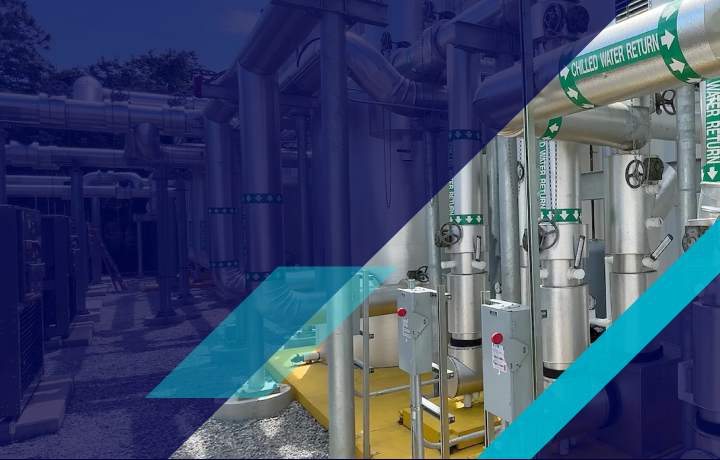What is a hyperscale data center?
What is a hyperscale data center? In simple terms, it’s a state-of-the-art facility built to store, process, and distribute the colossal amounts of data generated by the internet age. Hyperscalers surpass traditional data centers in size, capacity, and technological advancement, swiftly responding to the requirements of large data companies. This article explores how these digital giants operate, their impact on the tech landscape, and their critical role in the global data network.

Understanding hyperscale computing
In an era where the digital universe is expanding at a breakneck pace, hyperscale data centers and enterprise data centers stand at the forefront of this growth, providing the foundation for cloud services, the Internet of Things, and Artificial Intelligence (AI). Despite the data center myths you may have heard, these facilities are much more than just warehouses filled with servers; they are highly specialized environments designed for vast data processing and storage, capable of accommodating the ever-fluctuating demands of the digital age.
Brief history of hyperscale data centers
Hyperscale data center defining characteristics—purpose-built design, immense compute capacity, and optimized connectivity—serve the needs of hyperscale companies catering to millions of hyperscale customers.
In the early days of the Internet, there was a need for centralized storage and processing to serve the needs of businesses that were just beginning to recognize the value of data. As the internet flourished, so did the demand for more powerful and expansive infrastructure. The early 2000s marked a pivotal turning point with the advent of cloud computing. Tech giants began to build their own data centers, capable of managing immense volumes of data and traffic. These were the precursors to the hyperscale centers we see today, distinguished by their ability to scale rapidly to meet the increasing demand.
Today's hyperscale data centers are designed with an eye toward future expansion and the next wave of digital services. They've come a long way from their predecessors, and their evolution mirrors the growth of the internet itself—expansive, relentless, and indispensable to the digital experience.
Characteristics of hyperscale data centers
With facilities that cover hundreds of thousands of square feet, hyperscale data centers are built for digital infrastructure. Inside, nearly every aspect, from server capacity to cooling systems, is engineered for efficiency and scalability, ensuring the data center can meet the needs of vast data processing and storage.
Scalability and redundancy
To truly comprehend the scale of hyperscale data centers, one must picture facilities that:
- House more than 5,000 servers
- Sprawl across a footprint measured not just in square footage but in acres
- Occupy millions of square feet
- Go beyond the basic definition of large-scale data storage and processing
Easy-to-assemble design
More than just size, hyperscale data centers are modular, constructed using standardized components that can be quickly assembled, disassembled, and reconfigured to meet the ever-changing demands of the industry. These modules, whether they house servers, storage, or power supplies, speed up construction times but also enable a level of flexibility that traditional data centers can't match.
This easy-to-assemble design extends to the data center's infrastructure as well. Advanced network fabric, power distribution systems, and liquid cooling units are all built with plug-and-play functionality. This ensures that as the technology evolves, the data center's own hardware can, too, without significant overhauls or downtime.
Fundamental workloads of hyperscale data centers
Hyperscale data centers are engineered to handle fundamental workloads that include but are not limited to, cloud computing services, big data analytics, and content delivery networks.
Cloud computing services are perhaps the most significant of these workloads, offering scalable resources such as compute power and storage to businesses and individuals on demand. This flexibility allows users to access services and infrastructure via the internet without the need for physical hardware on-site, revolutionizing the way organizations operate.
Big data analytics is another primary workload, as hyperscale data centers provide the immense processing power required to analyze large datasets quickly and efficiently. Companies can gain insights into customer behavior, streamline operations, and make informed decisions by leveraging the computational might of hyperscale facilities.
Content delivery networks (CDNs) are also a key workload managed by hyperscale data centers. CDNs store content in multiple, geographically dispersed servers to ensure faster delivery and high availability to end-users, enhancing the user experience for consumers worldwide.
Additionally, hyperscale data centers are instrumental in supporting the backbone of various internet-based services that we rely on daily, including social media platforms, online marketplaces, and streaming services. These workloads demand high-capacity network infrastructure, robust server ecosystems, and advanced security measures to protect data integrity and privacy.
Key components of hyperscale data center connectivity
Hyperscale data centers are significantly larger than what most companies could imagine requiring and rely on key components to manage the immense processing load they handle daily.
Compute and storage systems
The compute and storage systems are the backbone of any hyperscale data center, providing the raw power and capacity required to process and store vast amounts of data. These systems are meticulously designed to be highly scalable, allowing for rapid expansion as the needs of the data center grow. They are built using the latest technologies in processing and memory, ensuring maximum efficiency and performance.
Network infrastructure
The network infrastructure of a hyperscale data center is critical for maintaining fast and reliable communication between thousands of servers and storage systems. This infrastructure includes high-speed cabling, sophisticated networking hardware, and advanced software that manages the flow of data, ensuring it is delivered quickly and without interruption.
Power and cooling systems
Power and cooling systems are essential for maintaining the optimal performance of hyperscale data centers. These systems are designed to be energy-efficient, using innovative technologies to reduce the overall power consumption of the data center. Cooling systems are equally important, as they ensure that the temperature within the data center remains within safe operating limits, even as the amount of processing power increases.
The architecture of hyperscale data centers
The architectural blueprint of a hyperscale data center is a convergence of advanced technologies, where every component is planned and implemented to handle the astronomical scale of data and computing power.
Server design and hardware selection
The servers in hyperscale data centers are not off-the-shelf units but are often custom-built to optimize performance for specific workloads. This customization extends to every component, from the CPU and memory configurations to the network interfaces and storage systems.
Hardware selection is a strategic decision that impacts not only the current operations but also the future scalability and efficiency of the data center. The choice of hardware must align with the data center's operational goals, whether it's maximizing compute density, minimizing power consumption, or achieving the best cost-to-performance ratio.
Network infrastructure
Stripped-down hardware and a high degree of disaggregation allow for modular infrastructure that can be rapidly adapted or expanded as necessary. Software-defined networking (SDN) and network function virtualization (NFV) allow hyperscale data centers to effortlessly manage resources, ensuring the network is always running at top efficiency, ready to adapt to new demands.
State-of-the-art cabling and high-performance switches and routers complete the network infrastructure, with redundancy and diverse network providers providing a safety net, guaranteeing uptime and seamless service around the clock.
Storage architecture
At the core of a hyperscale data center's prowess is its ingenious approach to handling workloads. By distributing tasks across a network of specialized server clusters and leveraging the latest in virtualization and load-balancing, these centers manage to keep data flowing smoothly and efficiently.
Benefits of hyperscale data centers
In this section, we delve into the myriad benefits that hyperscale data centers provide, from their robust infrastructure to their strategic role in driving the digital economy forward.
Enhanced data storage and processing capabilities
The hyperscale advantage is particularly evident when it comes to processing and analyzing vast amounts of data. The robust infrastructure of hyperscale data centers allows businesses to engage in big data analytics and insights, providing the processing and computing power necessary to identify patterns and trends, extract valuable insights, and make data-driven decisions.
Operational efficiency
When placed side by side with enterprise data centers or colocation data centers, hyperscale facilities distinguish themselves through their unparalleled scalability and ability to handle high-intensity workloads. While typical enterprise data centers do offer shared infrastructure options for businesses looking for cost-effective data storage and processing, they are minor in comparison to the specialized services and advanced networking technologies that hyperscale data centers provide.
Lower failure rates and higher redundancy
The economic footprint of hyperscale data centers is profound, offering a compelling value proposition over traditional data centers. They drive business and IT strategies, enabling cost savings, innovation, and the support of business-critical workloads.
Empowering cloud computing
Cloud services thrive on the agility and infrastructure provided by hyperscale data centers. These facilities are the engine rooms for cloud providers, offering high-speed connectivity that is crucial for on-demand, scalable infrastructure. As the cloud segment continues to dominate the hyperscale data center market, businesses benefit from the competitive pricing and superior service level agreements that hyperscale facilities can offer.
Challenges in hyperscale data centers
While hyperscale data centers offer many advantages, they are not without their challenges. From the complexities of energy consumption and cooling requirements to the intricacies of security protocols and the relentless demand for rapid expansion, hyperscale data centers must navigate several difficulties.
Managing energy efficiency
The energy demands of running thousands of servers, along with the associated cooling and power infrastructure, are immense. To tackle this, hyperscale data centers employ advanced energy efficiency strategies such as using air distribution systems for cooling outside air and warm-water cooling systems, as well as implementing smart temperature controls that adapt to both the internal and external environment. These strategies are complemented using energy-efficient hardware and the optimization of server utilization rates to ensure that energy consumption is kept to a minimum without compromising performance.
Moreover, the adoption of renewable energy sources is a growing trend among hyperscale data center operators. Solar panels, wind farms, and even geothermal energy are increasingly being integrated into the power mix, reducing reliance on fossil fuels, and minimizing carbon footprints. Operators are also exploring the use of energy storage systems, such as batteries and flywheels, to store excess energy generated during off-peak times for use during peak demand periods.
In addition to these measures, hyperscale data centers are often designed with power usage effectiveness (PUE) in mind. PUE is a metric used to determine the energy efficiency of the equipment that supports a data center by comparing the total amount of energy consumed by the facility to the energy delivered to computing equipment. Hyperscale data centers strive for a PUE close to 1.0, which would indicate that nearly all energy consumed is used for computing with minimal waste on ancillary functions.
Handling massive volumes of data
Navigating the complex web of data sovereignty and regional legal frameworks is a critical aspect of hyperscale data center operations. Operators must distribute their facilities strategically across regions to ensure compliance and operational efficiency.
The placement of these centers is also influenced by the significant power requirements, prompting data center operators to locate them in areas with access to cheap electricity and away from critical power grids. This strategic positioning is as much about the efficient operation of the data centers as it is about respecting and adhering to the nuances of national and regional data governance.
However, the exclusivity and high cost of hyperscale data centers mean they are not a one-size-fits-all solution. Smaller companies, when deciding how to choose a data center provider, might find better value in the redundancy and compliance benefits offered by colocation data centers, which provide a more accessible entry point into the world of data storage and processing.
Security concerns in hyperscale data centers
The security of hyperscale data centers is paramount, as breaches can lead to significant financial losses, legal repercussions, and damage to customer trust. To safeguard against these threats, hyperscale data centers employ a multi-layered security approach. This includes physical security measures such as biometric access controls, surveillance systems, and on-site security personnel, coupled with advanced cybersecurity protocols to protect against digital threats.
Transformative technologies for hyperscale data center connectivity
Cloud and virtualization technologies
In the ecosystem of hyperscale data centers, cloud and virtualization technologies play a foundational role. By creating virtual versions of hardware, storage, and network resources, these technologies allow for more agile deployment of services and a scalable infrastructure that can grow with demand.
Software-defined networking
Software-defined networking (SDN) revolutionizes traditional networking by decoupling the control plane from the data plane. This separation allows for centralized network management and dynamic resource allocation, thus improving network flexibility and simplifying the deployment of new services.
Intelligent network management solutions
Intelligent network management solutions are crucial for maintaining the complex networks of hyperscale data centers. These solutions provide real-time analytics and automated problem resolution, which are vital for optimizing performance and minimizing downtime in such expansive and data-intensive environments.
Growing adoption of AI and Machine Learning
AI and machine learning are increasingly being integrated into the future of data center technology to optimize workloads and enhance operational efficiency. AI/ML can predict and adjust for fluctuating workloads, optimize energy consumption, and automate routine tasks, leading to a smarter and more proactive management of resources.
5G and Edge Computing impacting hyperscale connectivity
The advent of 5G technology and the rise of edge computing are set to significantly influence hyperscale data center connectivity. With faster wireless speeds and lower latency, 5G enhances the ability of data centers to process and distribute data. Meanwhile, edge computing and edge data centers bring data processing closer to the source of data generation, reducing the strain on core data center resources and enabling new applications that require real-time processing capabilities.
“When you start to look at edge computing […] the need to have high-capacity connectivity as well as accessing gaming services that had latency requirements, you saw this revolutionary change in capacity to the edge. […] And when you have this latency requirement, network providers are addressing that. We have facilities in what were traditionally Tier 2 markets, so we're able to address that, we're able to create that distribution, and it's driving a much deeper relevance in some of these markets that were emerging over the past 10 or 15 years. They're now our prime core markets.”
—Ryan Mallory, COO, Explore the future of connectivity
Future of hyperscale data centers
As these facilities grow in number and size, their commitment to environmental stewardship grows as well, with many hyperscale facilities aiming for carbon neutrality and 100% renewable energy sourcing. Their comprehensive sustainability frameworks are setting the bar high for the industry, ensuring that the increasing demand these centers face does not come at an untenable environmental cost.
Advancements in technology
The technological landscape within hyperscale data centers is constantly evolving, with new advancements emerging at a rapid pace. These advancements encompass a broad spectrum of areas, including server hardware, storage solutions, networking capabilities, and energy efficiency measures. As technology progresses, hyperscale data centers are the first to adopt and integrate these innovations, ensuring they remain at the cutting edge of the digital infrastructure.
Impact of AI on hyperscale data centers
AI workloads are inherently compute-intensive, requiring significant processing power that goes beyond the capabilities of traditional data centers. As AI applications become more widespread and complex, the processing power needed to train and run AI models increases. This requires not just more data centers, but data centers that are designed for the high-density computing that AI demands.
As AI technologies evolve, they spur the creation of new services and applications, each adding to the already burgeoning demand for data center services. From smart cities to personalized healthcare, autonomous vehicles, and IoT, they all lean on the incredible compute and storage capabilities that only hyperscale data centers can provide. It's a symbiotic relationship; as one grows, so must the other.
Evolving trends in digital infrastructure
The hyperscale data center market is a competitive arena, with a projected CAGR of approximately 29.32% from 2023 to 2035. In contrast, the average data center may not experience the same level of growth. North America currently leads the market share, but the Asia Pacific region is gaining ground, fueled by social media usage and digital transformation initiatives.
The Banking, Financial Services, and Insurance (BFSI) sector is poised to witness considerable growth within this market, driven by an ever-increasing generation of data. As businesses across industries continue to evolve and embrace digitalization, hyperscale data centers will only grow in significance and influence within the global market landscape.
Flexential data centers
At Flexential, we understand the critical importance of data centers in today's digital landscape. Our facilities are designed to meet and exceed the demands of large-scale, data-intensive operations, providing the resilience, capacity, and cutting-edge technology necessary for businesses to thrive in the modern economy.
Flexential data centers are strategically located to ensure optimal connectivity and accessibility. We leverage the latest in design and technology to offer our clients the ability to scale rapidly and efficiently without compromising on performance or security. With Flexential, businesses can confidently manage their data workloads, knowing that they are supported by a robust and reliable infrastructure that is built to handle the complexities of today’s computing.
Learn more or take a data center tour today.





